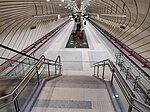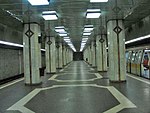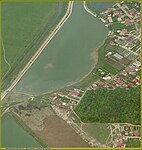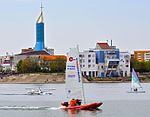Păcii metro station
1983 establishments in RomaniaBucharest Metro stationsEuropean rapid transit stubsRailway stations opened in 1983Romania transport stubs ... and 1 more
Romanian railway station stubs

Păcii (eng. [of the] peace) is a metro station in Bucharest. Part of the boulevard under which it resides used to bear the station's name. It is located on Iuliu Maniu Avenue at the intersection with Valea Cascadelor Avenue, the latter being a proposal for a new name for the station. The station was opened on 19 August 1983 as part of the extension from Eroilor to Industriilor.
Excerpt from the Wikipedia article Păcii metro station (License: CC BY-SA 3.0, Authors, Images).Păcii metro station
Bulevardul Iuliu Maniu, Bucharest Militari
Geographical coordinates (GPS) Address Nearby Places Show on map
Geographical coordinates (GPS)
| Latitude | Longitude |
|---|---|
| N 44.43403 ° | E 26.00538 ° |
Address
Păcii
Bulevardul Iuliu Maniu
061098 Bucharest, Militari
Romania
Open on Google Maps









